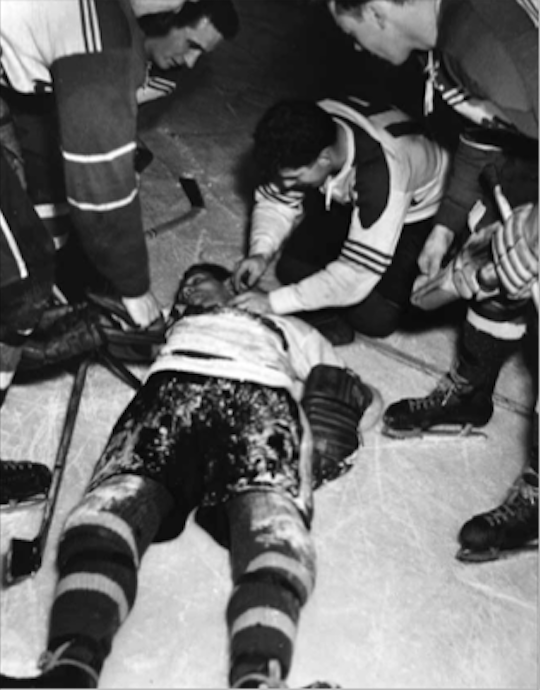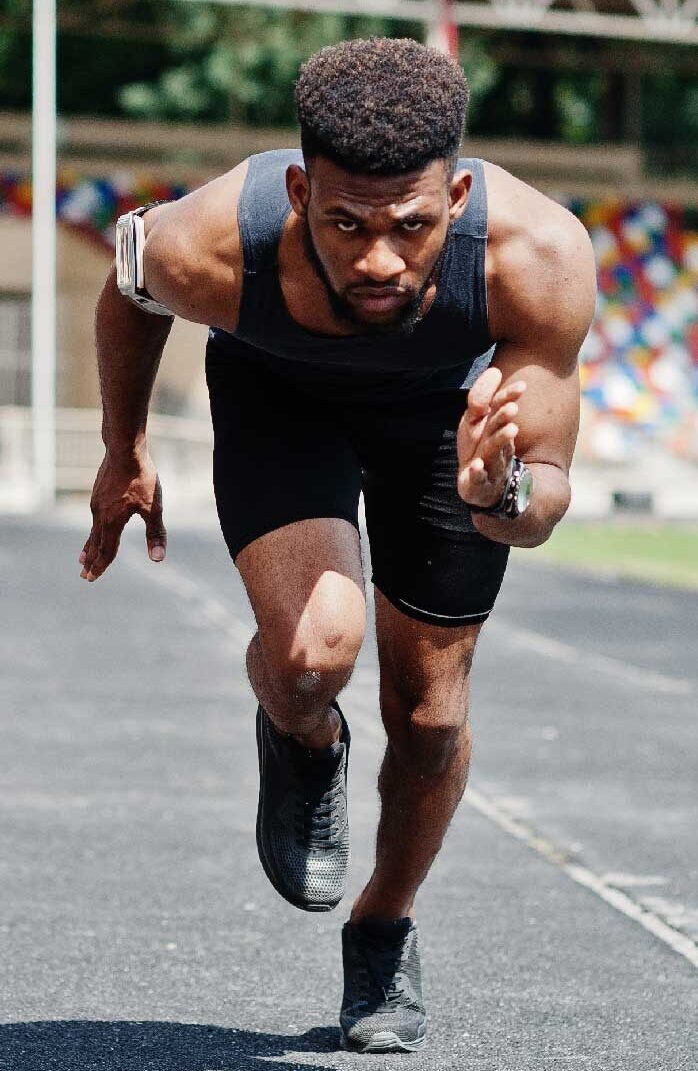The Medical
Perspective
So what does this all mean when it comes to the first line of defense—our trainer or athletic therapist?
Glen Bergeron, a professor and Chair of the Department of Kinesiology and Applied Health at the University of Winnipeg gives us a perspective from this discipline.
As an athletic therapist on the field, my focus is to recognize when an injury has occurred and take the most effective steps to immediately deal with the situation at hand. Some- times it is a minor injury and, once evaluated, the athlete is allowed to continue play. Other times some supportive taping or padding is required to protect the injured area, which allows the athlete to continue to play without causing further harm. In some cases, however, the injury can be much more severe and even life-threatening. There are times when the severity of the injury is obvious, such as a bone fracture or joint dislocation. Then we immediately call an ambulance and send the athlete to hospital, where they will receive advanced medical care.
In the case of head injuries, the symptoms are not always obvious to people other than the athletes themselves. Symptoms of concussion are often difficult to detect. The athlete may be experiencing confusion, blurred vision and headache, which can be easily masked. Remember, the motivation of the athlete is often to stay in the game at all costs. Other times the athlete may have more obvious symptoms, such as poor coordination and decision making during the game or a loss of balance.
During a game, the role of the athletic therapist or any other medical personnel on the field is to watch for impacts to the head or neck that may have caused a concussion. The athlete must be approached and evaluated, even if they do not come to you with complaints.
Although this may sound a little harsh, the role of the athletic therapist is to protect the athletes from the coaches, other athletes and parents and even from themselves. I say this by recognizing that all of these people, including the athletes, are in the heat of the moment and are focused on winning the game. The athletic therapist, despite being very much a part of the team and wanting the team to win, must take a more objective view and make difficult decisions based on what is best for the athletes, not necessarily for the outcome of the game. The consequences of a concussion can be short, medium or long term, and can even be fatal.

Ice hockey player Frachette is knocked out after hitting the goal post (circa 1950).
It is important to realize that even though symptoms at the outset can be minor in nature, the swelling of the brain can continue on for some time (24 to 48 hours and sometimes weeks and months) before the situation becomes critical. There is no way to predict whether or not the injury is going to progress to the critical stage. That is why every concussion injury has to be treated as a potentially serious injury until proven otherwise over time.
Athletes who have sustained a significant impact to the head or neck, with signs and symptoms of a concussion, must be immediately removed from the game and medically assessed over the next week or more to determine their readiness to return to play.
Prevention
The most important strategy for the prevention of concussions is EDUCATION, EDUCATION and EDUCATION. Although tremendous advances have been made in protective equipment, no piece of gear that prevents concussions has been developed. Helmets protect against head injuries, such as fractures and lacerations, but they do not protect the brain inside the skull. Athletes often believe they are protected and use their helmet as a tool to tackle or hit an opponent. Similarly, athletes think the opponent is protected by the helmet and will direct a blow to the opponent’s head with an elbow, stick or other body part. No matter how the hit occurs, the brain is being exposed to injury.
Athletes must recognize that the brain inside the skull is not protected from these types of blows or when the head hits the ground after a fall or tackle. They must also be educated about the consequences of a brain injury should they sustain or cause a concussion to someone else. Armed with this information, the athletes should be encouraged to follow fair and respectful participation in sport.
The responsibility of fair and respectful play goes beyond just the athlete. Coaches have a tremendous influence on the character and behaviors of the team as a whole and on every individual athlete on that team. It is the coach’s responsibility to instill and, in fact, insist on fair and respectful play. Proper coaching techniques on how to safely control an opponent and how to safely be controlled (hit) by an opponent is an essential part of coaching.
Officials also play an important role in injury prevention and detection. As much as officials are in a game to enforce the rules, they are also educators. They can control the tone of the game. It is the officials’ responsibility to prevent dangerous, aggressive behavior beyond the scope of the game that could lead to increasingly injurious activity. Officials are also another pair of eyes on the field who should be watching for the subtle signs of concussion. Erratic behavior, unusual comments and other strange actions should be reported to the coach or medical staff, so the athletes can be further assessed.
Officials should be supportive of the medical staff when they are assessing an athlete on the field. Officials can help control the crowd and other players around the injured athlete and communicate any necessary information to the sidelines. They should not be pressuring the medical staff to rush the on-field assessment.

Parents play an obvious role in the prevention of concussions in children.
Much like the coaches, the parents must in still in their sons or daughters an attitude of respect for their opponents, the officials and, in fact, the game itself. There should be no “win at all cost” mentality. There is no such thing as a good penalty. Parents should have realistic expectations of their children and should encourage them to pursue their desired level of play, while at the same time maintaining a respectful attitude for the opponent and the game.
Fans also play an important role in injury prevention. As fans, we reward athletes’ actions on the field of play with our cheers and comments. Athletes respond to those cheers by repeating the behavior. If we reinforce violent and dangerously aggressive behavior, we are part of the problem. Fans should also not impede coaches and officials in their responsibility to ensure a safe environment for play. Verbal and sometimes physical attacks on coaches and officials simply add to the negative environment in which the athletes are asked to perform.
The media can have a positive or negative influence on this issue and must not glorify the “heroics” of playing injured, especially with a concussion. The media is a powerful tool for educating the public at the most opportune time—when the athlete is injured and on the field. The comment “He has just had his bell rung” or any similar sentiment that trivializes the injury should not be uttered by the media. The fact is the athlete has sustained a brain injury that could have severe short- or long-term consequences. The media should support the athlete, medical staff and team officials in pursuing a conservative approach to a brain injury.
In summary, prevention of concussion is everybody’s responsibility. It all comes down to the promotion of a safe and respectful environment, where athletes, parents, coaches, officials and fans can come to the rink or field for one reason— to have fun.
Get Involved
Whether you want to make a donation or get involved with our team, your help is always appreciated!
Donations are used towards funding educational material for coaches, parents, and teachers and allow us to continue our work in general. If you want to work with us or become an ambassador to help spread the word, please don’t hesitate to contact us! If you are interested, click one of the buttons on the right.
About Us
StopConcussions is a non-profit company, that aims to bring players, parents, coaches and officials information on brain concussions and their consequences in contact sports.
This website is here to help educate and are not intended to replace medical care and/or professional supervision. There is no substitute for a competent neurologist, physician, health professional or clinician when it comes to diagnosing and managing concussions. What StopConcussions offers is an insight into the nature of a brain injury. It is a guide to help you understand the cause, effects and consequences of concussions as well as how you can help reduce the incidences of the injury, manage the injury better and be able to ask all the right questions when dealing with a concussed individual.
The brain is complex, and each injury is personalized. Not only is every brain different, so is every concussion, and the therapy must be tailored to each individual. With this said, only a physician or qualified healthcare professional who has been educated in concussions can recommend a treatment and rehabilitation program. If you have any questions or concerns regarding a specific injury, contact your physician immediately.
Contact Us
Whether you need help dealing with a concussion, need information or other materials or are a concerned parent or coach, we are happy to help. Please contact us with any and all inquiries regarding our field.
